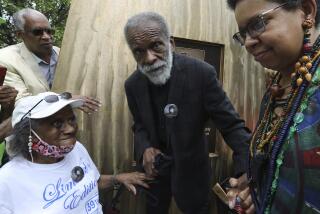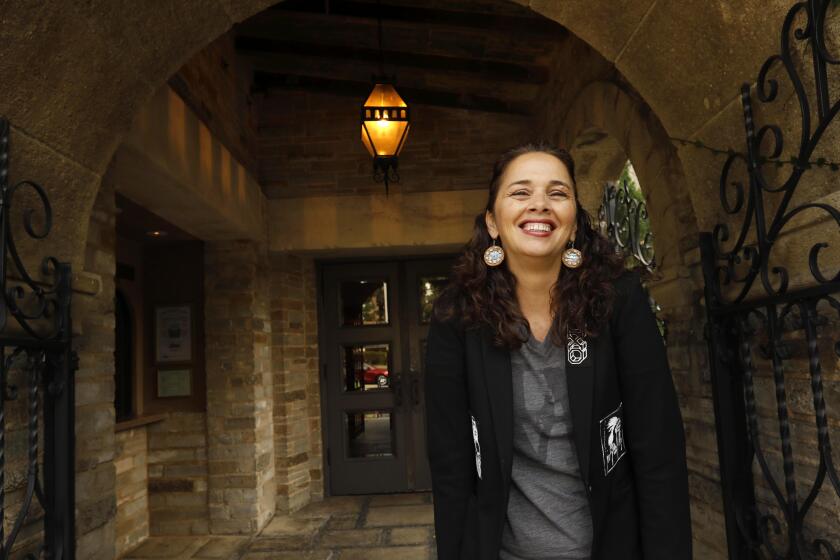Commentary: Remembering David Driskell, whose landmark 1976 show insisted: Black art matters
When the American Bicentennial came around in 1976, art museums across the country scrambled to acknowledge the event.
One of the most enduring exhibitions — “Two Centuries of Black American Art: 1750-1950” — was organized for the Los Angeles County Museum of Art. The guest curator was David C. Driskell, who died last week in Maryland from COVID-19 at the age of 88. His passing in this terrible moment prompts reflection.
His show sought to fill a huge gap in traditional American art history, which barely mentioned the work of African American artists — especially those working before the Black Arts Movement of the civil rights era and the Harlem Renaissance of the 1920s. What it did was harness a major platform during a historic moment simply to insist: Black art matters.
Driskell’s was a landmark show, but it almost didn’t happen — for exactly the reason it needed to be done. A matching curatorial gap yawned wide.
In established art museums that claimed significant commitments to American painting and sculpture, curatorial scholarship on the subject of black art remained scant — too scant for such a high-profile moment as the bicentennial of the nation’s founding. Compared with other mostly schmaltzy or unimaginative bicentennial museum offerings around the country, such a show would stand out.
In Washington, D.C., the old National Collection of Fine Arts (now the Smithsonian American Art Museum) chose to organize the first survey of Emanuel Leutze, the German immigrant whose famous “Washington Crossing the Delaware” is the hoariest chestnut in all of American history painting. Its companion National Portrait Gallery did “Abroad in America: Visitors to the New Nation 1776-1914,” a show featuring pictures of 34 tourists from Europe, South America, Asia and Africa.
Across the street from the White House, the Corcoran Gallery of Art, now defunct, hosted a rather bizarre event that then toured the country. For “America 76,” organized at the behest of the U.S. Department of the Interior, 45 living artists received commissions. They were asked to choose subjects related to department programs — implicit promotional material for the U.S. Fish and Wildlife Service, U.S. Bureau of Mines, the Bonneville Power Administration in the Pacific Northwest and more.
There were others, including “A Bicentennial Treasury: Masterpieces From the Metropolitan Museum,” a lazy reshuffling of greatest hits from the permanent collection, and the Museum of Modern Art’s blinkered “American Art Since 1945,” composed almost entirely of paintings by local New York artists. (The only work made in L.A. was, ironically, by African American artist Daniel LaRue Johnson.) Almost all are long since forgotten, and deservedly so.
One exception was the Whitney Museum of American Art’s “200 Years of American Sculpture.” (The founder of the museum, Gertrude Vanderbilt Whitney, was herself a sculptor.) It was partly memorable because — like African American art — museum sculpture shows have historically gotten short shrift. They’re unwieldy and expensive to mount.
Of all the bicentennial exhibitions that proliferated that year, however, only one has come down to us four decades later as a milestone — a turning point in scholarship and a template for curatorial shrewdness.
Driskell’s “Two Centuries of Black American Art: 1750-1950” was the first exhibition I saw at LACMA, having moved from New York to Southern California just a few months before its Sept. 30 opening. On view were 205 paintings, sculptures, prints, drawings and crafts by 57 men and nine women — plus some who were anonymous — and whose creative lives were established between the 18th and the mid-20th centuries.
It wasn’t a perfect show. It didn’t always feature the finest examples. Sometimes a viewer was left wanting more.
But those were quibbles. What it accomplished in raising the profile of black art was more important.
Driskell, the guest curator, was a young painter and historian at Fisk University in Nashville. The historically black school had been established for the education of freedmen at the end of the Civil War.
After the LACMA show, the curator went on to a long career at the University of Maryland, where the David C. Driskell Center for the Study of the Visual Arts and Culture of African Americans and the African Diaspora was established in 2001. His LACMA exhibition inspired a CBS television documentary, “Hidden Heritage: Two Centuries of Black American Art,” whose popularity with viewers in turn inspired a program for the Arts Council of Great Britain. Driskell’s raised profile got him a gig advising Bill Cosby on art collecting.
One surprise in his black art exhibition was the inclusion of “Virginian Partridge,” a dramatic 1830 John James Audubon graphic showing a fierce red hawk going after a covey of fluttering quail. Audubon’s ethnicity was news to me, as it doubtless was — and probably still is — to many.
The son of a French slave owner and merchant sailor in Haiti and his mistress, a Creole chambermaid believed to have been a slave, the artist was raised in France. As a teenager, Audubon immigrated to the United States using a false passport.
In other words, if he showed up today, some would seek to immediately deport the nation’s greatest, universally beloved wildlife artist — a French African American undocumented immigrant.
Driskell subtly underscored Audubon’s tangled yet all-American biography, long since submerged beneath the brilliance of “The Birds of America,” his famous compendium of naturalist renderings. The show included an 1860 lithographic portrait of the artist by Jules Lion, a popular New Orleans printmaker and daguerreotypist. The print, based on an earlier work by British portrait miniaturist Frederick Cruickshank, does not divulge Audubon’s ethnicity through any visual cues.
Point taken.
To complicate things further, Lion himself may or may not have been black. Born in Paris, he was recorded in one Louisiana city directory with the letters “f.m.c.” — free man of color — attached to his name. It’s the only known reference to the successful artist’s racial identity.
The Audubon work was lent to the show by LACMA trustee Sidney Brody, a real estate investor and art collector who helped choose black art history as the museum’s bicentennial topic in conversations with two fellow trustees: Franklin D. Murphy, former UCLA chancellor and then chairman and chief executive officer of Times Mirror Co., then-parent of the Los Angeles Times; and Robert Wilson, a stock broker and the board’s only African American member.
They, in turn, were no doubt responding to the entreaties of the Black Arts Council. Claude Booker and Cecil Fergerson, art preparators at the museum, had formed the group in the aftermath of the 1965 Watts rebellion to agitate for diversified programming.
One deep, permanent stain on America’s founding is its fraught acceptance of white ownership of black human beings. An art exhibition held during a frothy bicentennial celebration that would nonetheless confront the awful fact was bold and brave.
When the idea for the show was presented to LACMA’s curatorial staff, however, it said no. The refusal, Driskell later observed, did not spring from racial animus. Curators instead realized they were unequipped to tackle the subject. Trustees turned to L.A. artist Charles White for advice, and he led them to Driskell.
Charles White was a spectacular draftsman.
As an artist himself, the curator had a special sensitivity. (A Driskell painting retrospective is currently being organized by the Portland Museum of Art in Maine and Atlanta’s High Museum.) The vagaries of ancestry are especially acute for many African Americans, largely because the slave trade severed familial links both within American life and to African origins. One of the show’s undercurrents was a tension between personal memory and the cultural associations artists made with African history and art.
Romare Bearden, the great collage artist, is emblematic. Bearden was represented by half a dozen works in the show, most of them fusing myth and remembrance.
His compact 1964 collage “Sermons: The Walls of Jericho,” marked by a vibrant Cubist explosion of fragments of African sculptures and black faces, was made in the decisive year of the Civil Rights Act. Inspired by biblical narrative and Picasso’s radical use of African art in the Cubist revolution, the dynamic image flares as a Black Power icon — as a wall of repression comes tumbling down.
“I don’t really see that there is any major difference between what black artists and white artists do,” Driskell once recalled Bearden telling him. “We bring our own experiences into the art [without] trying to keep up with the current trends of being in vogue.” That philosophy guided the exhibition.
The show made a point of stopping short of including postwar artists, skirting the issue of what might or might not be fashionable. Its critical reception reflected some dissatisfaction with that position. Past artists got the bigger critical nod, while limiting inclusion of living artists to those who emerged before 1950 was seen as problematic.
Writing in this newspaper, critics Henry J. Seldis and William Wilson each applauded the show, although both took special note of gifted 19th century artists like Maryland portraitist Joshua Johnson, Midwest landscapists Robert S. Duncanson and Edward Mitchell Bannister, and European expats Edmonia Lewis and Henry Ossawa Tanner. (Tanner’s somber “Daniel in the Lion’s Den,” the show’s only painting from LACMA’s collection, is a biblically derived image of innocent human survival in the face of fierce animal threat.) Seldis registered discomfort with what he perceived to be “separatism” in a show built around the artists’ shared ethnicity.
Needless to say, museum exhibitions composed of all-white artists virtually never caused similar critical distress. When “Two Centuries of Black American Art” got to the Brooklyn Museum (it also traveled to Atlanta and Dallas), Hilton Kramer, the New York Times’ lead art critic, was horrified, as expected, by what the reliably conservative reviewer claimed was “more interesting as social history than for its aesthetic revelations.”
Kramer, in a characteristically obnoxious choice of words given the black art subject, bemoaned a “refusal to discriminate” between artistic quality and failed aspiration.
Driskell was wryly amused. In an oral history for the Archives of American Art a quarter-century later, he credited the inflammatory Kramer review with securing the show’s significance — if only because the most prominent establishment newspaper had gotten all huffy about it.
“Hilton Kramer?” he astutely replied to Tom Brokaw when asked about the negative review on NBC’s July 4, 1977, “Today” show. “What does he know about black art?”
Unmentioned, however, was a second New York Times story — this one a perceptive preview by the paper’s art reporter Grace Glueck, published the day before the show’s Brooklyn opening. She got straight to the point, praising the way it “forced the examination of work that might otherwise be bypassed,” while “documenting the way [artists] have functioned in often daunting circumstances.”
Although white, not black, Glueck knew from experience what she was talking about.
The reporter was then in the throes of a high-profile class-action lawsuit, filed together with six other women employees in Federal District Court, charging the New York paper with sex discrimination. (The plaintiffs prevailed in 1978.) Four weeks after Driskell’s “Two Centuries of Black American Art” closed at LACMA, the museum opened “Women Artists: 1550-1950” — the first major international survey of its subject. It traveled to Brooklyn too.
“Women Artists” was a second landmark exhibition, and the second show I saw at the museum. Driskell had landed the first of a one-two punch that changed how we see the world.
More to Read
The biggest entertainment stories
Get our big stories about Hollywood, film, television, music, arts, culture and more right in your inbox as soon as they publish.
You may occasionally receive promotional content from the Los Angeles Times.







